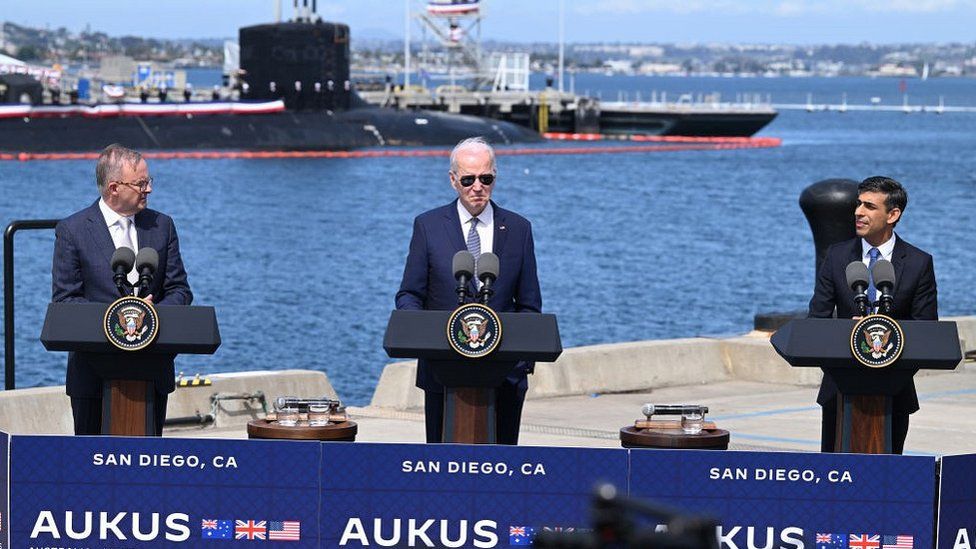The US, UK and Australia have unveiled details of their plan to create a new fleet of nuclear-powered submarines, aimed at countering China’s influence in the Indo-Pacific region.
Under the Aukus pact Australia is to get its first nuclear-powered subs – at least three – from the US.
The allies will also work to create a new fleet using cutting-edge tech, including UK-made Rolls-Royce reactors.
Beijing has strongly criticised the significant naval deal.
Its foreign ministry on Tuesday accused the three nations of “walking further and further down the path of error and danger”.
China’s UN mission had earlier also accused the Western allies of setting back nuclear non-proliferation efforts.
But US President Joe Biden said the deal was aimed at bolstering peace in the region and stressed the submarines would be “nuclear-powered, not nuclear-armed”.
Speaking alongside the UK and Australian prime ministers – Rishi Sunak and Anthony Albanese – in San Diego, California, Mr Biden said the deal would not jeopardise Australia’s commitment to being a nuclear-free country.
For Australia, it is a major upgrade to the US ally’s military capabilities. The country becomes just the second after the UK to receive Washington’s elite nuclear propulsion technology.
The submarines will be able to operate further and faster than the country’s existing diesel-engine fleet and Australia will also be able to carry out long-range strikes against enemies for the first time.
Under the deal, Australian navy sailors will be sent to US and UK submarine bases from this year to learn how to use the nuclear-powered submarines.
From 2027, the US and UK will also base a small number of nuclear submarines in Perth, Western Australia, before Canberra will buy three US-model Virginia-class submarines in the early 2030s – with options to purchase two more.
After that, the plan is to design and build an entirely new nuclear-powered submarine for the UK and Australian navies – a model that is being called SSN-AUKUS.
This attack craft will be built in Britain and Australia to a British design, but use technology from all three countries.
President Biden said all three countries were committed to ensuring the Indo-Pacific region would remain free and open.
“Forging this new partnership, we’re showing again how democracies can deliver our own security and prosperity… not just for us but for the entire world,” he said.
He also pledged of $4.6bn (£3.7bn) to expanding the US’ submarine construction capacity and improving maintenance of its current nuclear-powered Virginia-class submarines.
Australia’s PM said the plan – which will cost Canberra up to A$368bn (£201bn) over 30 years – marked the “biggest single investment in Australia’s defence capability in all of its history”.
Anthony Albanese said building the submarines in Australian shipyards would also create thousands of local jobs. The UK PM also said thousands of jobs would be created in Derby and Barrow-in-Furness, where some of the construction would take place.
Mr Sunak said that in the 18 months since the Aukus alliance was unveiled, the challenges to global stability had only grown.
“Russia’s illegal invasion of Ukraine, China’s growing assertiveness, the destabilising behaviour of Iran and North Korea – all threaten to create a world codefined by danger, disorder and division,” Mr Sunak said.
As part of his visit to the US, Mr Sunak has also pledged to increase defence spending by nearly £5bn ($6bn) over the next two years to counter threats from hostile states.
The Aukus security alliance – announced in September 2021 – has repeatedly drawn criticism from China. Beijing’s foreign ministry last week reiterated its position that the pact risked creating an arms race.
But the three Western countries say the security deal is aimed at shoring up stability in the Indo-Pacific.
While all three leaders have stressed how the deal will strengthen their co-operation, it hasn’t been without its political fallout.
In 2021, Australia scrapped a multi-million dollar diesel-powered submarine agreement with France in favour of the trilateral agreement – causing a political rift with Paris.
Australia also faces a delicate diplomatic situation with China – its largest trading partner. Analysts say the question will be whether it can continue to strengthen its military ties with US, while fostering commercial ties with Beijing.
Source : BBC

